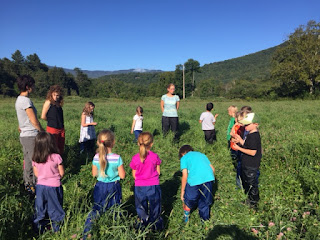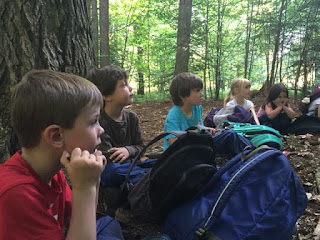Several weeks ago we began Writers Workshop. We read the book Library Mouse, by Daniel Kirk, about a young mouse who lives in a hole in the wall of a library. At night he comes out to read all of the wonderful books. He decides to try writing himself and discovers that writing is quite fun and not all that hard, especially when you write about what you know.
On Mondays we always write about our weekends. This is a consistent routine that children come to love and I find gives me a wonderful lens into children's writing growth over time. On other days children have been writing about any topic they choose, but if they feel stuck for ideas I encourage them to write about what they know. At this point most children are using pictures to convey a story, dictating words to me when they are ready. We have worked on adding details to our writing, either in the pictures or by adding more words or new related pages. As we begin to learn more and more letters and some sight words, children will begin attempting their own words. Generally this begins with writing first sounds in words, but I encourage children to write any sounds they hear or any letters they think belong. A few of us are already eagerly beginning this process. We have been writing for about 20 minutes and then sharing the work of a few children each day, which is a wonderful way to inspire each other and spread ideas and strategies.
Thursday, September 29, 2016
Thursday, September 22, 2016
On Wednesday we had a fantastic day for ECO. After reading The Salamander Room by Anne Mazer, children were invited to create their own red eft houses. In past years we have made mouse houses, but noticed that at this time of year there are lots of red efts in the forest, so we decided red eft houses was more fitting. Children were encouraged to be creative and let their imaginations lead the way. As they were building several noticed red efts already moving in!
Wednesday, September 21, 2016
Each day after morning meeting we move into math. Typically students are in small groups moving through two stations each day. Our focus thus far has been on exploring math materials that we will be using throughout the year as well as counting quantities up to 10 and writing the corresponding numeral. We have also played some partner games, something we will do lots of this year. We always practice a game a couple of times as a whole group, with me on one team and the rest of the class on the other team. Children know that the games are intended to be a fun way to practice essential math skills and the most important thing when they play a game is to be a good sport. We have talked about what this looks like for both the person who loses and the person who wins the game, and we always end our games by shaking hands and saying "good game!"
Tuesday, September 13, 2016
On Tuesday morning we were extremely fortunate to have the opportunity to vote on the town dog tag shape and color for the coming year. Jen Peterson, our town clerk, and Kellee Mazer, very graciously came to school and talked us through the voting process. The ballot box was locked and children went up one at a time to cast their votes. After everyone had voted Jen unlocked the box and we counted the votes. Purple was the color choice, but there was a tie for shape between flower and hexagon, so we had to have a run off vote. In the end hexagon won by one vote. So next year look for purple hexagon dog tags as voted on by the kindergarten class! Thank you to Jen and Kellee for taking the time to give kindergarteners this hands on civics experience.
 |
| Reviewing the voting process. |
 |
| Making a choice. |
 |
| Adding ballots to the locked box. |
 |
| Counting the votes. |
Monday, September 12, 2016
We had an exciting morning on Monday as all of our butterflies emerged from their chrysalises. Before we released them we talked about things they (and all living things) would need to survive. We noted that while we could provide them with water and air, eventually it would be hard to supply them with nectar (food), and certainly the space we had for them as caterpillars is no longer adequate once they are butterflies. We wished them well and set them free on a beautiful morning to begin their journey south.
Friday, September 9, 2016
During our first two weeks of school much of our focus has been on developing a warm and caring classroom community in which all children feel safe and welcome, feelings essential for learning. For young children, a critical first step in this process is helping them develop an awareness of their own feelings and emotions. This week we have been talking about the Zones of Regulation, four categories or "zones" used to categorize different emotions people experience: blue, green, yellow, and red. Green is optimum. People in the green zone might be feeling happy, calm, or focused. Blue is running slow-perhaps tired, sick, or sad. Yellow represents caution-frustrated, overwhelmed, silly, worried, or anxious. Finally the red zone is for extreme emotions and feeling out of control- terrified, angry, or completely overwhelmed. To help us practice identifying the zones we read the book "On Monday When It Rained..." by Cherryl Kachenmeister, which describes the range of feelings for one boy in a given week, and emphasizes that all people, even adults, cycle through various emotions every day. We brainstormed strategies for moving toward the green zone when we aren't feeling our best. Some of our ideas include taking deep breaths, finding a space by ourselves, counting to five (or higher), or sitting with a drip toy.
We also read the book "Have You Filled a Bucket Today" by Carol McCloud, which talks about the rewards of treating other people with kindness. When you fill someone else's bucket your own bucket fills as well. In the coming days we will be paying close attention to the particular acts that fill our buckets each day.
We also read the book "Have You Filled a Bucket Today" by Carol McCloud, which talks about the rewards of treating other people with kindness. When you fill someone else's bucket your own bucket fills as well. In the coming days we will be paying close attention to the particular acts that fill our buckets each day.
Wednesday, September 7, 2016
We had a wonderful first day of ECO. Much of our focus was on establishing ECO routines and boundaries and getting to know our space in the forest. It was a bit warm for a walk back but everyone did a terrific job! Thank you for your help with sending children well prepared. (And thanks to Katie Babic and Kasara Gage for sharing the photos.)
We begin our ECO mornings in the field, singing a song together, sharing something that we are thankful for, and playing a game. Then we head into the forest.
We begin our ECO mornings in the field, singing a song together, sharing something that we are thankful for, and playing a game. Then we head into the forest.
When we arrive at our space in the woods we gather around the safety circle. We often share interesting things we noticed on our walk, and as the seasons progress, changes we see in our surroundings. Today some of the things we noticed were crickets chirping, a chickadee singing, some places where the tall grass was trampled, a spider in its web, and a toad. Next it is time for snack and a story.
When everyone has finished snack we move into our guided exploration for the morning. This is the part of our routine that typically changes each week. Today children worked with a partner exploring our space and collecting three 3-4 interesting things that could fit in a paper bag.
We decided that when it comes to living things we will try to to treat them the way they would want to be treated and we will observe them with our eyes, but not pick them up.
After each group collected their objects we gathered back in the circle. Rather than looking at what each group collected, we took a few moments to pass the bags and notice the objects with our hands. Tomorrow we will empty each bag to see what was found.
Finally we ended our morning by sitting quietly in a space by ourselves for a couple of minutes, noticing how different the forest is when we are all quiet. In the coming weeks each child will choose a sit spot for this purpose, to be revisited during each ECO session throughout the year.
We end by saying goodbye to the forest and then walking back to school.
Subscribe to:
Posts (Atom)













































